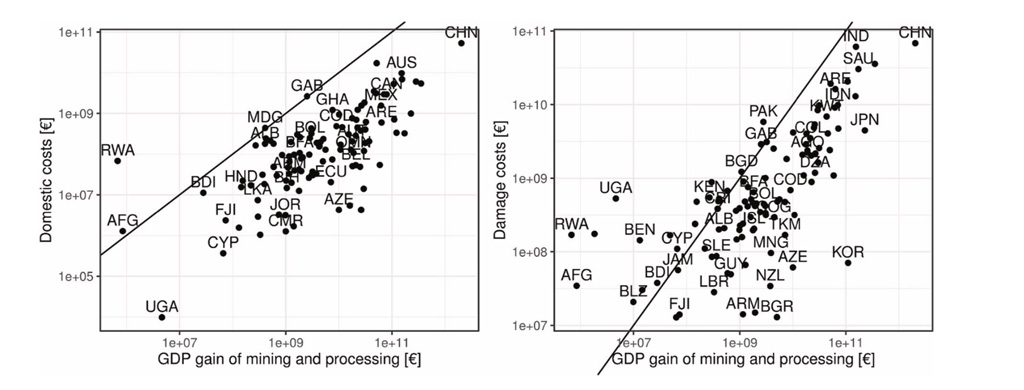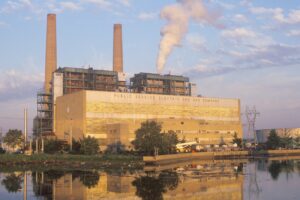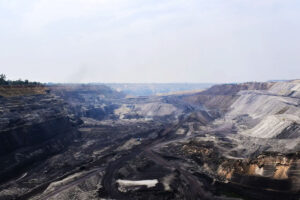
Emissions from mining cause ‘up to £2.5tn’ in environmental damages each year
Anastasiia Zagoruichyk
07.06.22Anastasiia Zagoruichyk
06.07.2022 | 12:47pmGreenhouse gas emissions from global mining and resource extraction result in up to £2.5tn ($3tn) in damages worldwide every year, according to a new study.
Extractive industries provide the world with fossil fuels, metal ores and mineral resources, but the new research, published in the Journal for Cleaner Production, finds that their total environmental costs amount to as much as £4tn ($5tn) every year. Most are attributed to greenhouse gases, particulate matter and acidification – particularly from the coal and steel sectors.
UN secretary-general António Guterres has called mineral resources one of Earth’s “great endowments”, which plays a “dominant role” in the economies of dozens of countries. Indeed, the study demonstrates that, for most countries, the mining sector delivers larger economic gains than losses.
However, it also concludes that for some vulnerable countries – such as Gabon, Madagascar and Afghanistan – the environmental costs could exceed the economic gains. This chimes with what is often described as the “resource curse”, referring to links between mineral extraction and negative outcomes, such as inequality and environmental destruction.
With fossil fuel extraction representing nearly half of the environmental costs – without including the combustion of the resulting fuels – the authors say the findings highlight the benefits of moving towards cleaner energy sources.
Working out costs
While natural resources can bring wealth and jobs to countries, extracting them can also cause harm to human health, biodiversity and the environment. With this in mind, the research team estimates the ratio between these costs and the economic gains that these industries bring.
To do this, they analysed the global production of 38 raw materials – such as coal, iron and natural gas – using databases from the US and British geological surveys.
The researchers conducted a life-cycle assessment (LCA) using a “cradle-to-gate” approach. This assesses the environmental impacts – including greenhouse gas emissions, particulate matter emissions, acidification, land-use change, resource depletion and toxicity – associated with all the stages of a product’s life, but not including use.
Therefore, the combustion of fossil fuels is not included, which allows for “a cost-benefit perspective from the extracting countries’ point of view”, the paper says.
The study focuses on the health impacts of these activities, such as the respiratory diseases and skin disorders suffered by miners, as well as the loss of biodiversity due to habitat loss and degradation.
The LCA results were then “monetised” to produce numbers that could be compared with other economic indicators. This involves conversion of indicators such as mortality, damage to nature, loss of species into monetary values.
To underline the uncertainty associated with monetisation, the researchers used a “high” and “low” monetisation factor for each respective endpoint. Rosalie Valeska Arendt from the Technical University of Berlin, who led the study, explains to Carbon Brief:
“For the high estimate we included future effort costs. These are costs that occur because the concentration of ores and material deposits decline, so that more energy and work needs to be invested to extract them. For the low estimate, these costs are excluded, because the costs of mining have historically decreased despite decreasing ore grades. If future effort costs are included, they dominate all other costs and the impact of fossil energy carriers becomes even more pronounced.”
One of the main novelties of the study is that the research team compared the calculated environmental costs of countries with their GDP and level of employment. For most countries, the damages exceeded £420 ($500) per employed person, apart from some African countries where the costs were lower.
The scientists wanted to show the difference between local and global costs of mining. For this they assumed “all impacts to be local impacts apart from global warming”, the paper says, meaning that the study does not consider the “transboundary effects of air, soil and water pollution”.
‘Resource curse’
The authors conclude that overall environmental costs generated by extraction industries globally are £0.3tn ($0.4tn) per year in the low estimate, representing 0.5% of the world’s £71tn ($85tn) annual GDP.
Taking into account future effort costs, this amount rises to £4tn ($5tn) annually, representing 6.4% of global GDP. The study notes that 64% of all these costs result from climate change, meaning between £0.3tn ($0.3tn) and £3tn ($3tn) caused by extraction-related greenhouse gases alone.
For climate change, the mining of materials “contributing most to environmental damage are iron (23%), coal (18%), magnesium (13%), crude oil (10%), aluminium (8%) and manganese (7%)”, the paper says.
Overall, 43% of the costs arise from harm that has been caused to ecosystems, while 21% are related to human health impacts.
As a group of materials, fossil fuels contribute disproportionately to the environmental damages, representing 43% of the total costs. Oil was associated with the highest costs, followed by natural gas and coal.
While much has been made of the environmental harm tied to the minerals involved in the clean energy transition, Valeska Arendt tells Carbon Brief:
“We talk about speciality metals for future technologies, but when we look at total environmental costs today, the impacts of steel, aluminium and fossil energy carriers are still dominant.”
The charts below show the scale of production for each material (left), the distribution of damages for each material (middle), and the damage costs for the different impacts (right) for the “low” cost estimate.

Losses vs gains
When countries’ domestic costs are assessed without including global climate damages, the study concludes that, overall, mining is more beneficial from an economic point of view for the majority of countries.
The nations with the largest environmental costs – China, Brazil, India and Russia – all have higher benefits than costs associated with their mining activities.
However, for the high “global” estimate, when the damages linked to climate change are included, 20 countries’ GDP losses are higher than the benefits they gain from mining activities. These countries are clustered in Africa, Central and South America and south-east Asia and are “severely impacted by climate change”, the paper says.
For the low estimate, environmental costs exceed economic gains only for a handful of countries: Rwanda, Gabon, Madagascar and Afghanistan.
The charts below illustrate how GDP gain from mining compares to local (left) and global (damages) for individual countries. All countries to the left of the line have costs that exceed the economic benefits.

The distribution of climate change costs around the world is based on a study led by Prof Katharine Ricke and published in Nature Climate Change. Valeska Arendt explains to Carbon Brief:
“If climate change costs are added to the domestic costs, more countries have a negative cost-to-benefit ratio (their total environmental costs exceed their GDP contribution for mining and processing), but these costs of climate change are not carried by the extracting countries themselves.”
The study finds that countries involved in processing materials – such as steelmaking in Germany and Japan – and oil-producing countries – such as Algeria, Azerbaijan and Nigeria – gain the most economic benefits. This is because they “largely externalise environmental costs of upstream and downstream processes”, the paper says, meaning that their environmental costs are carried by society as a whole.
The highest greenhouse gas emissions all come from activities in China, particularly the production of iron, steel, coal, magnesium and aluminium, the paper says. However, Dr Daniel Smith from the University of Leicester, who was not involved in the study, tells Carbon Brief that he is somewhat surprised by this as China’s magnesium production is “really quite low”.
The next highest contributors are natural gas extraction in the US and Russia, the study says, followed by manganese mining and production in South Africa.
Future research
The authors note that the main limitation of the study is a lack of data for full-scale analysis. As Valeska Arendt explains to Carbon Brief, “the paper is only a global estimate and I hope that we can refine this analysis in more detail in the future”.
She also notes that “we were not able to differentiate between the mining and processing of all materials, as the life-cycle assessment databases did not supply enough process steps in between mining and processing”.
Nevertheless, she adds that “future research could focus more specifically on a single material identified as significant”.
Another issue is highlighted by Dr Simon Jowitt, a geological scientist at University of Nevada, who was not involved in the study. He tells Carbon Brief that setting the environmental costs in relation to the share of GDP that is generated by mining is “a little misleading”.
For example, he explains, the value of Germany’s mined resources is large, but it accounts for just 0.5% of its GDP. These resources may be “way more than countries we would consider mining-dominated, such as the Democratic Republic of the Congo, Zambia, Mexico and so on”. A substantial portion of Germany’s mining will be coal, which is “environmentally problematic”, says Jowitt, but “using the contribution of mining to GDP as a value causes [the environmental damages] to be artificially lower” as a result of the higher overall GDP of the German economy.
The authors acknowledge that their paper does not include every environmental impact – for example, they exclude the harm caused to marine and freshwater species.
Dr Gavin Mudd, a mining researcher at the Royal Melbourne Institute of Technology who was not involved in the study, adds:
“[There is] no recognition of the numerous other potential impacts associated with mining either – especially water pollution, water depletion, acid rain and particulate pollution associated with smelters”.
Nonetheless, the authors argue in their paper that their research provides “many valuable insights into the environmental impacts of mining and processing worldwide”. They continue:
“We identified which countries benefit, from a cost-benefit perspective, from the continuation of local mining activities, which is valuable if a game theoretical analysis of fading out the extraction of fossil resources is aimed for.”
And they add that “the approach we developed can be used to analyse different large-scale developments in changing patterns of resource extraction”.
Valeska Arendt et al (2022), The global environmental costs of mining and processing abiotic raw materials and their geographic distribution, Journal of Cleaner Production, doi: 10.1016/j.jclepro.2022.132232
-
Emissions from mining cause ‘up to £2.5tn’ in environmental damages each year




